I’m climbing a somewhat rickety ladder when it occurs to me (not for the first time) that I really shouldn’t be doing this.
It’s September. Fall migration is getting underway. And I am in the very heart of one of birding’s holiest of high holy places: Cape May, New Jersey, that small curve of land between the Atlantic Ocean and the Delaware Bay where millions of birds spend at least some part of their lives, year over year, season over season.
I should be stalking warblers in the meadow not climbing a ladder to get up close and personal with, well, a roof.
Must Touch the Living Roof
In my defense, it’s not just any roof—it’s the new green (living) roof on the small building at the entrance to the Conservancy’s South Cape May Meadows Preserve. And it is lush and green, rippling with life and lined in stainless steel that looks like tarnished silver beneath the lowering sky.
It is a roof so alive it makes the building, with its weathered wooden sides, look like a natural part of the landscape, as if it had sprouted from the preserve’s native seed bed, like dune grasses or bayberry trees. And I really want to touch it.
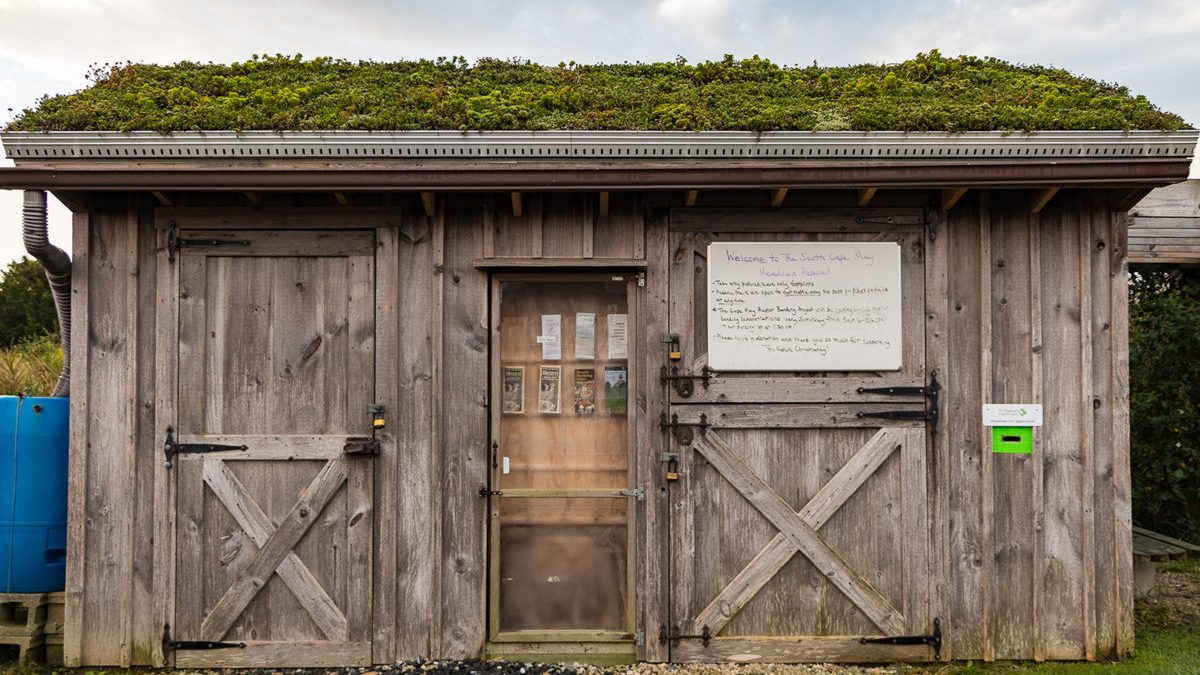
Fortunately, Conservancy stewardship assistant, Trisha Seelman, understands my obsession perfectly. She is, after all, the one who led the project to install it earlier in the summer.
“It’s great, isn’t it?” she calls up to me as I begin to explore. “Everyone who visits stops to ask about the green roof.”
Since the preserve gets more than 90,000 people a year past its entrance building, that’s a lot of opportunity to evangelize the many practical values of a green roof: storm water management, providing food for pollinators and other beneficial insects, and keeping the air-conditioning and insulation-free building significantly cooler in summer and (hopefully) warmer in winter. (This will be the first winter with the green roof so Trisha cautions that, while she’s hopeful, she’s taking a wait and see attitude on whether it will be warmer.)
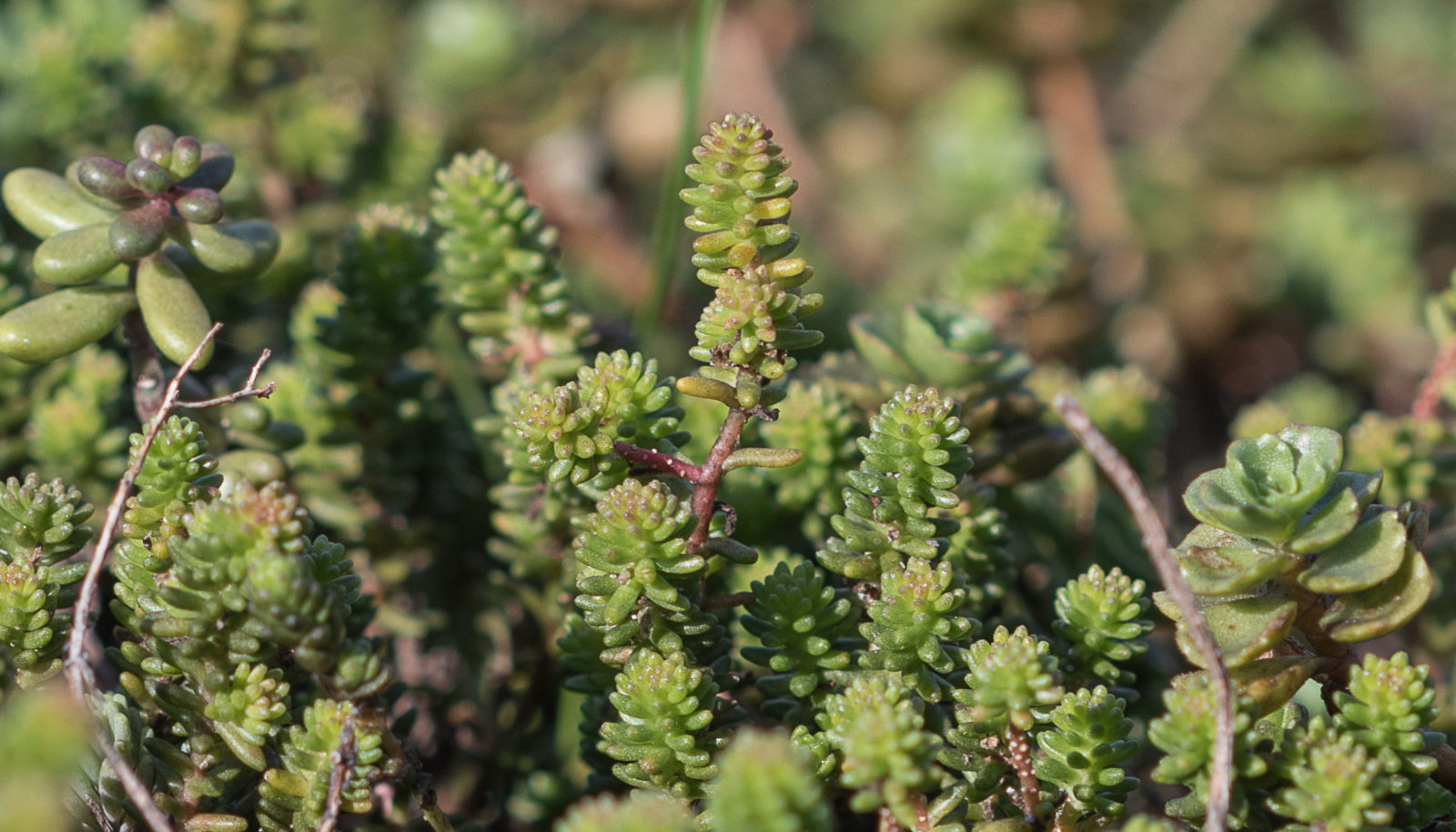
The plants that make the green roof so lush are sedums, sometimes called stonecrops, in a blend of species suitable for the variable New Jersey climate. Up close, they look like miniature versions of plants that might have sheltered the tyrannosaurs and velociraptors of the Cretaceous.
The leaves, many that look to be more lobe than leaf, are lush and cool to the touch, even in the heat and hard light of a September afternoon. And, since sedums are succulents that tend to be drought tolerant, low maintenance and bloom throughout the year, they are magnets for all manner of butterflies, bees and birds.
They are also, clearly, magnets for curious, ladder-climbing writers who are practically shirking a moral duty to bird with diligence while in Cape May. I still feel a little guilty about that, but at least I’ve finally figured out why I’m standing on this roof. It’s about the metaphor and the microcosm.
It’s About Shelter
I should have seen it earlier. Is there any simpler or more nearly universal human metaphor for shelter than a roof? And the microcosm? It’s the building and its living roof that feels like it’s breathing at my feet. In a way, this small building, a mix of man made and nature made, is the secret at the heart of South Cape May Meadows revealed in microcosm, a story of wood, soil, sedums, and stainless steel reflecting the larger story of the preserve itself.
Because the secret of this 200-acre preserve isn’t a secret at all. In some circles, South Cape May is less famed for its millions of migratory birds, than for its successful restoration, managed hydrology, and the many ways its combination of man-made and nature-made habitats helped protect the town of South Cape May from flooding during Hurricane Sandy in 2012.
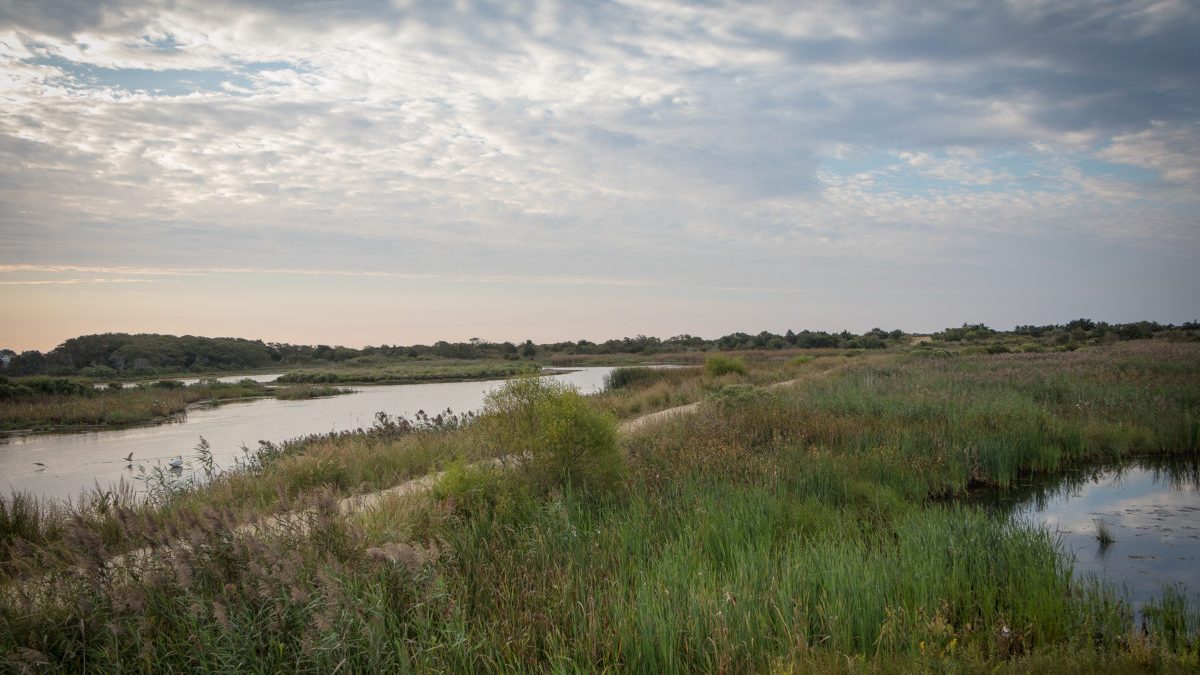
With its managed hydrology, wood and steel weirs, levees that double as hiking trails, replanted dunes and revived meadows, South Cape May Meadows is a kind of green roof writ large.
It shows that shelter for people doesn’t have to come at the expense of shelter for the plants and animals that share the world with us. In fact, Cape May shows the opposite, that protecting or restoring habitats healthy enough to support and shelter plants and animals is good for people, too.
Standing on this living roof, I can see shelter—for people, for plants, for animals—everywhere all around me. It’s in the sturdy wooden building beneath my feet, and in the restored freshwater wetlands full of mallards that sound like Shakespeare’s cackling witches. It’s in the replanted meadows where warblers I can never name on the first try dodge and weave among the sunflowers, and it’s in the slender wind-curved grasses and the dark green bayberry trees that mark the high line of the dune ridge.
And though I can’t see it from here, I take heart in knowing that just beyond that ridge, beneath the sheltering sky, sand-colored ghost crabs haunt the wide crescent beach between the dune grasses and the sea.
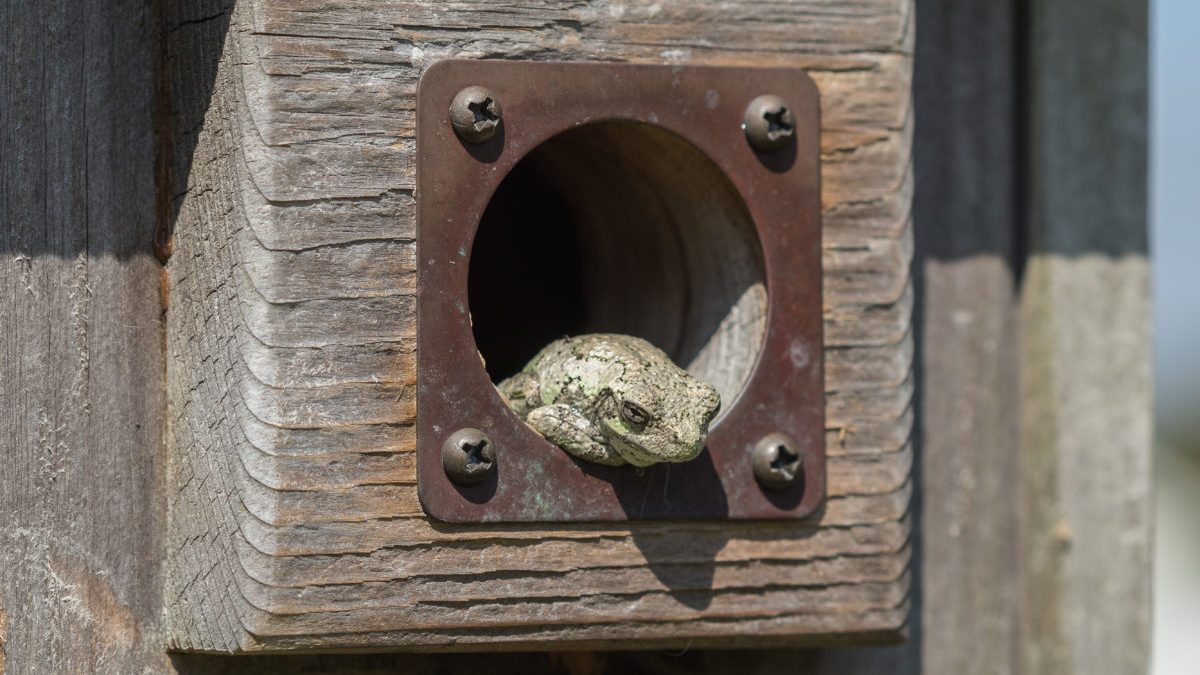
Climbing down from my perch, I’m pleased I’ll have a little time to stalk the wetlands for birds, but before I hit the trail, South Cape May offers one last—and somehow perfect—story of shelter told in one frame: a gray tree frog lounging in the sunny opening of an empty bluebird nesting box.
Shelter. It’s everywhere around us. Like the gray tree frog, we just have to learn how to know it when we see it.
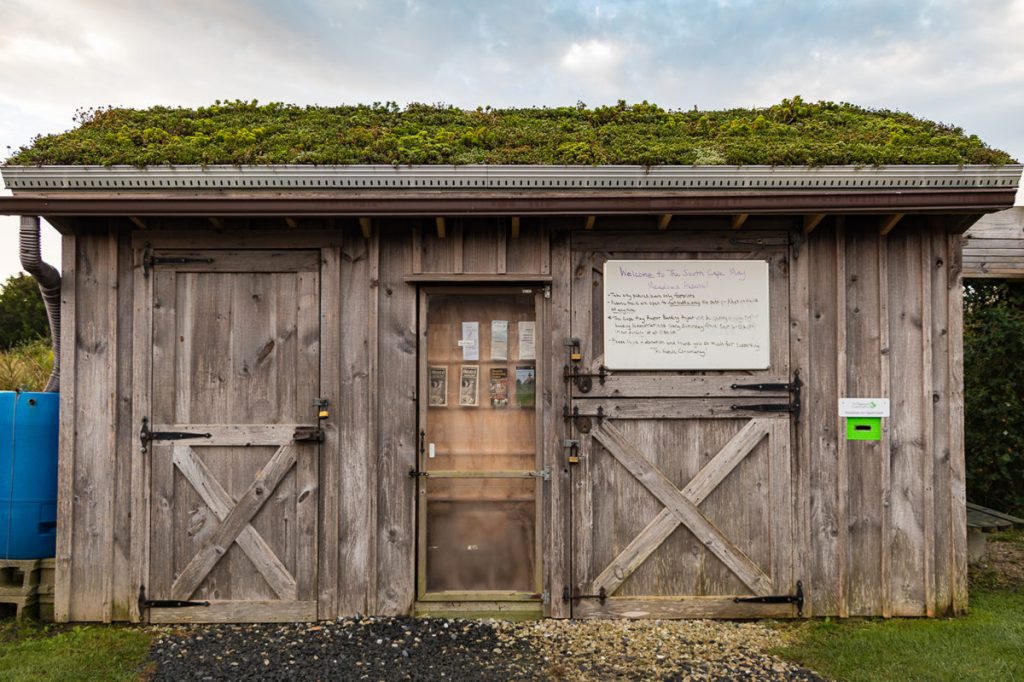



I have a boat house in northern Minnesota, with the usual aging shingle roof. I was aiming to top it with an aluminum roof that should last for a long, long time. Can I top the aluminum roof with stuff that will encourage a green, living roof?
jmilton
Don’t really have a comment, other than to say “Great work!”! Perhaps in the future I’ll have something worthwhile to say. Love the green roof!
What a great idea. Didn’t the City of Chicago do that on some of their municipal buildings. When you look out of a high window in Chicago, you see lots of rooftop gardens. I would love to do this for my beach house in South Carolina. Afraid the neighbors would object. What about maintenance from the inside with all the rain that could collect?
Such an interesting story. Makes me wish I lived in a house with a suitable for a roof like this. Makes the birds safe from the cats in the neighborhood.
I live in an earth house or underground house. (I mow my roof). It has 8 tons of dirt & sand, grass & weeds on it. Made the best cantaloupes & watermelons when my folks grew a veggie garden up there. Your artical gave me an idea to grow different things up there maybe for the bird population of Texas. Thanks. Would like to know more about this. Kitty
Until the mid 20 century most houses in Iceland were constructed with roofs made of turf. Because there were no native forests to provide wood, they made do with drift wood, rocks, and turf. Walls were constructed from sod bricks. Some of these houses have been preserved as museums. I recently visited one with 16 rooms, completely furnished. Warm in winter and cool in summer.
Love this! Thank you…..
Cara’s smile must inspire others to do the kind of work she’s doing! Thank you. Cara
Thanks for sharing. My only concern is whether the species are native sedums or not? They look very much like my sedum species on my green roof, and mine aren’t native. My green roof is in an urban environment, but in a wildlife habitat like that, it could be critical that the species are native – as pieces can fall off the roof. Being suitable for an environment may yield too suitable! Be watchful for invasive actions. You had mentioned native grasses – I am thinking of the same thing – changing my nonnative species over to native ones. Still, green roofs provide amazing benefits as you mentioned. Congraulations.
Here’s another blog about green roof installation. https://www.washingtonpost.com/news/where-we-live/wp/2013/08/14/a-petworth-homeowners-green-roof-one-year-later/
Thank heaven for finding another intelligently presented story from which to learn. My son,who is now gone, used to bird there and absolutely loved to be there. Wonderful, inspiring ideas. Thank you.